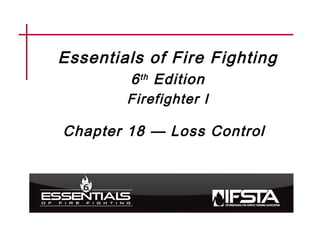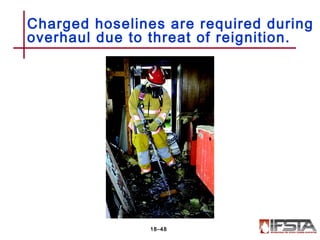EFF I Chapter18
- 1. Essentials of Fire Fighting 6th Edition Firefighter I Chapter 18 ŌĆö Loss Control
- 2. Explain the philosophy of loss control. Learning Objective 1 18ŌĆō2
- 3. Loss control activities minimize loss to property before, during, and after a fire. 18ŌĆō3
- 4. The are two types of damage it is important to know about. 18ŌĆō4
- 5. Two tactics firefighters use are intended to reduce property damage. 18ŌĆō5
- 6. REVIEW QUESTION How does the philosophy of loss control impact fire suppression? 18ŌĆō6
- 7. Describe the ways preincident planning impacts loss control. Learning Objective 2 18ŌĆō7
- 8. Preincident planning can help identify special loss control-related concerns. 18ŌĆō8
- 9. Preincident plans vary depending on the type of occupancy. 18ŌĆō9 Residential occupancies Commercial properties
- 10. REVIEW QUESTION In what ways can preincident planning influence loss control? 18ŌĆō10
- 11. Determine appropriate salvage procedures. Learning Objective 3 18ŌĆō11
- 12. Compare and contrast different types of salvage covers. Learning Objective 4 18ŌĆō12
- 13. Salvage begins upon arrival on scene and continues until the last unit leaves. 18ŌĆō13
- 14. There are various ways to perform salvage and the choice of procedure depends on several factors. 18ŌĆō14
- 15. Salvage procedures include three main methods of protecting contents. 18ŌĆō15
- 16. There are several salvage techniques firefighters should understand. 18ŌĆō16
- 17. Commercial occupancies may present unique challenges. 18ŌĆō17
- 18. Water presents a number of challenges during salvage operations. 18ŌĆō18
- 19. REVIEW QUESTION What is the best way to determine appropriate salvage procedures? 18ŌĆō19
- 20. Salvage operation assignments vary depending on the department. 18ŌĆō20
- 21. There are various types and sizes of salvage covers. 18ŌĆō21 Disposabl e heavy- duty plastic
- 22. Proper maintenance can help increase the service life of a salvage cover. 18ŌĆō22
- 23. Salvage requires a specific collection of tools and equipment stored in a designated toolbox or container. 18ŌĆō23 (Cont.)
- 24. Salvage requires a specific collection of tools and equipment stored in a designated toolbox or container. 18ŌĆō24 (Cont.) Automatic Sprinkler Kit
- 25. Salvage requires a specific collection of tools and equipment stored in a designated toolbox or container. 18ŌĆō25 (Cont.) Floor runnersCarryall
- 26. Salvage requires a specific collection of tools and equipment stored in a designated toolbox or container. 18ŌĆō26 (Cont.) Dewatering device Water vacuum
- 27. Salvage requires a specific collection of tools and equipment stored in a designated toolbox or container. 18ŌĆō27
- 28. REVIEW QUESTION What are the different types of salvage covers commonly used in the fire service? 18ŌĆō28
- 29. Explain ways to fold, roll, spread, and improvise with salvage covers. Learning Objective 5 18ŌĆō29
- 30. Describe ways to cover openings during salvage operations. Learning Objective 6 18ŌĆō30
- 31. There are several different methods for folding/rolling and spreading covers. 18ŌĆō31
- 32. Improvised salvage covers catch and route water away from a location. 18ŌĆō32
- 33. REVIEW QUESTION Why is it necessary to know several ways to fold, roll, spread, and improvise with salvage covers? 18ŌĆō33
- 34. Covering openings is critical to prevent further damage to the property. 18ŌĆō34
- 35. REVIEW QUESTION What ways can firefighters cover openings during salvage operations? 18ŌĆō35
- 36. Explain methods used to maintain fire safety during overhaul. Learning Objective 7 18ŌĆō36
- 37. Describe factors that influence locating hidden fires. Learning Objective 8 18ŌĆō37
- 38. Identify different overhaul procedures. Learning Objective 9 18ŌĆō38
- 39. Indicate the ways a thermal imager can be used during overhaul. Learning Objective 10 18ŌĆō39
- 40. Overhaul consists of activities conducted once the main body of a fire is extinguished. 18ŌĆō40
- 41. Overhaul begins once authorization is given by two personnel. 18ŌĆō41
- 42. A variety of tools and equipment are used during overhaul. 18ŌĆō42
- 43. Specific personnel perform different duties during overhaul. 18ŌĆō43
- 44. Safety is the first consideration that must be addressed before overhaul. 18ŌĆō44
- 45. Toxic gases produced from smoldering fire are a significant threat. 18ŌĆō45
- 46. CAUTION Wear proper protective clothing including self-contained breathing apparatus (SCBA) until the atmosphere has been proven safe. 18ŌĆō46
- 47. Many other hazards are present during overhaul that you should be aware of. 18ŌĆō47
- 48. Charged hoselines are required during overhaul due to threat of reignition. 18ŌĆō48
- 49. Situational awareness and a focus on safety are critical during overhaul. 18ŌĆō49
- 50. REVIEW QUESTION What methods can be used to maintain fire safety during overhaul operations? 18ŌĆō50
- 51. The structural condition of an area must be evaluated before searching for hidden fires. 18ŌĆō51
- 52. There are several indicators of possible loss of structural integrity. 18ŌĆō52 (Cont.)
- 53. There are several indicators of possible loss of structural integrity. 18ŌĆō53
- 54. There are four methods to use when locating hidden fires. 18ŌĆō54
- 55. REVIEW QUESTION How can a firefighter describe the factors that influence locating hidden fires? 18ŌĆō55
- 56. Overhaul procedures should begin as soon as possible after the order is given. 18ŌĆō56 (Cont.)
- 57. Overhaul procedures should begin as soon as possible after the order is given. 18ŌĆō57 (Cont.)
- 58. Overhaul procedures should begin as soon as possible after the order is given. 18ŌĆō58 (Cont.)
- 59. CAUTION When pulling any ceiling, stand clear of any falling debris. 18ŌĆō59
- 60. Overhaul procedures should begin as soon as possible after the order is given. 18ŌĆō60
- 61. REVIEW QUESTION What are some of the overhaul procedures used in the fire service? 18ŌĆō61
- 62. Using thermal imagers during overhaul has benefits and disadvantages. 18ŌĆō62
- 63. REVIEW QUESTION How can using a thermal imager be useful during overhaul? 18ŌĆō63
- 64. ŌĆó Loss control is an important component of fire department service delivery with the philosophy of minimizing secondary damage to structures and their contents during and after fire control operations. ŌĆó Salvage and overhaul operations are two of the most effective means of loss control. Summary 18ŌĆō64 (Cont.)
- 65. ŌĆó It is very important for fire personnel to identify and protect valuable contents in structures affected by fire as well as searching for hidden fires so rekindling does not occur. Summary 18ŌĆō65 (Cont.)
- 66. ŌĆó Taking a customer-service oriented approach to loss control ensures that citizensŌĆÖ property is adequately protected and that the reputation of the fire service is held in the highest regard. Summary 18ŌĆō66
- 67. Clean, inspect, and repair a salvage cover. This objective is measured in Skill Sheet 18-I-1. Learning Objective 11 18ŌĆō67
- 68. Roll a salvage cover for a one- firefighter spread. This objective is measured in Skill Sheet 18-I-2. Learning Objective 12 18ŌĆō68
- 69. Spread a rolled salvage cover ŌĆö One-firefighter method. This objective is measured in Skill Sheet 18-I-3. Learning Objective 13 18ŌĆō69
- 70. Fold a salvage cover for a one- firefighter spread. This objective is measured in Skill Sheet 18-I-4. Learning Objective 14 18ŌĆō70
- 71. Spread a folded salvage cover ŌĆö One-firefighter method. This objective is measured in Skill Sheet 18-I-5. Learning Objective 15 18ŌĆō71
- 72. Fold a salvage cover for a two- firefighter spread. This objective is measured in Skill Sheet 18-I-6. Learning Objective 16 18ŌĆō72
- 73. Spread a folded salvage cover ŌĆö Two-firefighter balloon throw. This objective is measured in Skill Sheet 18-I-7. Learning Objective 17 18ŌĆō73
- 74. Construct a water chute without pike poles. This objective is measured in Skill Sheet 18-I-8. Learning Objective 18 18ŌĆō74
- 75. Construct a water chute with pike poles. This objective is measured in Skill Sheet 18-I-9. Learning Objective 19 18ŌĆō75
- 76. Construct a catchall. This objective is measured in Skill Sheet 18-I-10. Learning Objective 20 18ŌĆō76
- 77. Make a chute and attach it to a catchall. This objective is measured in Skill Sheet 18-I-11. Learning Objective 21 18ŌĆō77
- 78. Locate and extinguish hidden fires. This objective is measured in Skill Sheet 18-I-12. Learning Objective 22 18ŌĆō78














































































